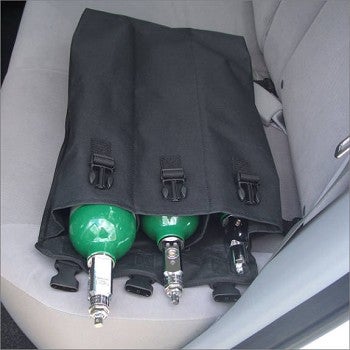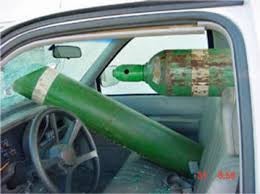 "71MGBGT Likes Subarus of Unusual Colors" (adamprotter)
"71MGBGT Likes Subarus of Unusual Colors" (adamprotter)
10/21/2019 at 19:28 • Filed to: None
 0
0
 17
17
 "71MGBGT Likes Subarus of Unusual Colors" (adamprotter)
"71MGBGT Likes Subarus of Unusual Colors" (adamprotter)
10/21/2019 at 19:28 • Filed to: None |  0 0
|  17 17 |
My wife is a medical professional who will need to transport a tank of O2 to and from different home visits in case of an emergency. How can this be done safely and what regulations need to be followed.

 Wacko
> 71MGBGT Likes Subarus of Unusual Colors
Wacko
> 71MGBGT Likes Subarus of Unusual Colors
10/21/2019 at 19:46 |
|
I would think that securely attached would be enough, I’m no expert but that’s the least I would do
 My X-type is too a real Jaguar
> 71MGBGT Likes Subarus of Unusual Colors
My X-type is too a real Jaguar
> 71MGBGT Likes Subarus of Unusual Colors
10/21/2019 at 19:49 |
|
My friend who does home healthcare has to have all kinds of travel documents, extinguisher in her car, signs stating she has in her car. Whether it is one or one hundred same regs have to be covered as it is prescription.
The employer should take care of those and the training.
 Cash Rewards
> My X-type is too a real Jaguar
Cash Rewards
> My X-type is too a real Jaguar
10/21/2019 at 19:56 |
|
Hmm. Surprised to hear it's not volume dependent. Some thjngo, like lithium for batteries, are.
 facw
> 71MGBGT Likes Subarus of Unusual Colors
facw
> 71MGBGT Likes Subarus of Unusual Colors
10/21/2019 at 19:57 |
|
I don’t know, but I looked around and it seems like there is all sorts of conflicting advice. Some things said always carry it in the passenger compartment (to protect against a rear-end collision), while others say never to do that. There seems to be some agreement that it’s a bad idea to leave the cylinders in the car when it is parked.
I also saw this which seems sort of cool, though I have no idea if it is safe:

https://www.cpr-savers.com/CarMate-Vehicle-Cylinder-Carrier—DE-3-Cylinder-Case_p_10207.html
H
ooks into the LATCH tether points to secure it.
Ultimately, if she’s doing this for work, I’d expect that they should be able to provide guidance on what the regulations are (assuming she’s not independent of course
).
 My X-type is too a real Jaguar
> Cash Rewards
My X-type is too a real Jaguar
> Cash Rewards
10/21/2019 at 20:18 |
|
It’s the medical use. A welder carrying a tank of O2 to a job has different rules and needs less paperwork.
 Cash Rewards
> My X-type is too a real Jaguar
Cash Rewards
> My X-type is too a real Jaguar
10/21/2019 at 20:19 |
|
That's incredibly stupid. Is that state or DOT rules?
 If only EssExTee could be so grossly incandescent
> 71MGBGT Likes Subarus of Unusual Colors
If only EssExTee could be so grossly incandescent
> 71MGBGT Likes Subarus of Unusual Colors
10/21/2019 at 20:19 |
|
Might need a flammable gas placard like what's required on the bags of trucks
 My X-type is too a real Jaguar
> Cash Rewards
My X-type is too a real Jaguar
> Cash Rewards
10/21/2019 at 20:28 |
|
Federal regs, it falls into 2 categories prescription medicines and haz mat.
Look at it this way, a first responder rolling up on an accident scene to an unconscious driver, the person is young appears in good health no reason to expect pressurized oxygen in the car. A welder will have all their gear present. Someone doing home healthcare not so much remember pure oxygen can make fabric go up like a kitchen match
 nermal
> 71MGBGT Likes Subarus of Unusual Colors
nermal
> 71MGBGT Likes Subarus of Unusual Colors
10/21/2019 at 20:30 |
|

Make sure it’s big enough to blow up a pesky shark!
 Cash Rewards
> My X-type is too a real Jaguar
Cash Rewards
> My X-type is too a real Jaguar
10/21/2019 at 20:35 |
|
That first responder scenario is an interesting point. And yeah, I understand the danger, which is why I wondered why there's the two different regs. Danger is the same. But I guess that one is a lot more obvious
 My X-type is too a real Jaguar
> Cash Rewards
My X-type is too a real Jaguar
> Cash Rewards
10/21/2019 at 20:40 |
|
Welders bottles are a lot larger
 ttyymmnn
> 71MGBGT Likes Subarus of Unusual Colors
ttyymmnn
> 71MGBGT Likes Subarus of Unusual Colors
10/21/2019 at 21:04 |
|
There is a guy who plays viola in the orchestra who always has an O2 bottle with him on stage. Which means he has it in his car everywhere he goes. I can ask him about it, but won’t see him again until Sunday.
 gmporschenut also a fan of hondas
> 71MGBGT Likes Subarus of Unusual Colors
gmporschenut also a fan of hondas
> 71MGBGT Likes Subarus of Unusual Colors
10/21/2019 at 21:53 |
|
I would look for something to properly latch it down.

 GLiddy
> facw
GLiddy
> facw
10/22/2019 at 00:08 |
|
Yeah, I wouldn’t transport them with the valves pointed outward. I would think a side impact might conceivably cause a breakage and release the gas uncontrollably. I’d go for valves inside for maximum protection.
 facw
> GLiddy
facw
> GLiddy
10/22/2019 at 00:17 |
|
I agree with that. The valves are presumably the weak point in a crash.
 pip bip - choose Corrour
> 71MGBGT Likes Subarus of Unusual Colors
pip bip - choose Corrour
> 71MGBGT Likes Subarus of Unusual Colors
10/22/2019 at 05:03 |
|
strap it to the roof?
 71MGBGT Likes Subarus of Unusual Colors
> My X-type is too a real Jaguar
71MGBGT Likes Subarus of Unusual Colors
> My X-type is too a real Jaguar
10/22/2019 at 08:05 |
|
My wife works for a small very small practice so she’s the one who’s been asked to figure this stuff out.